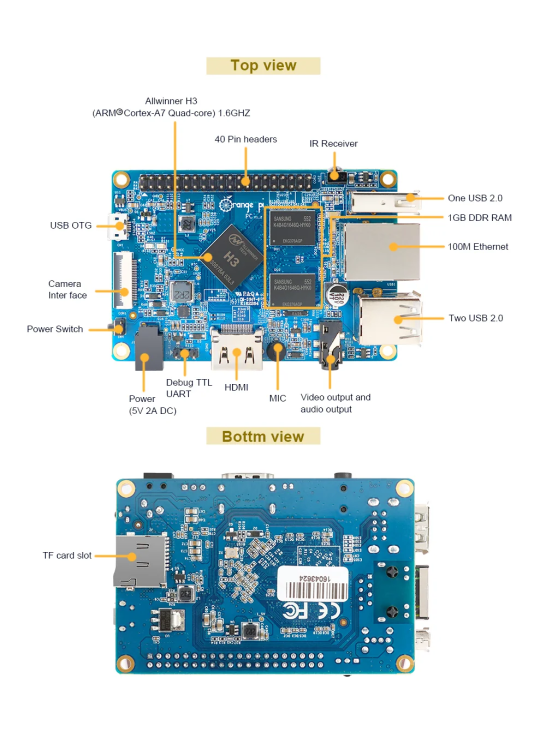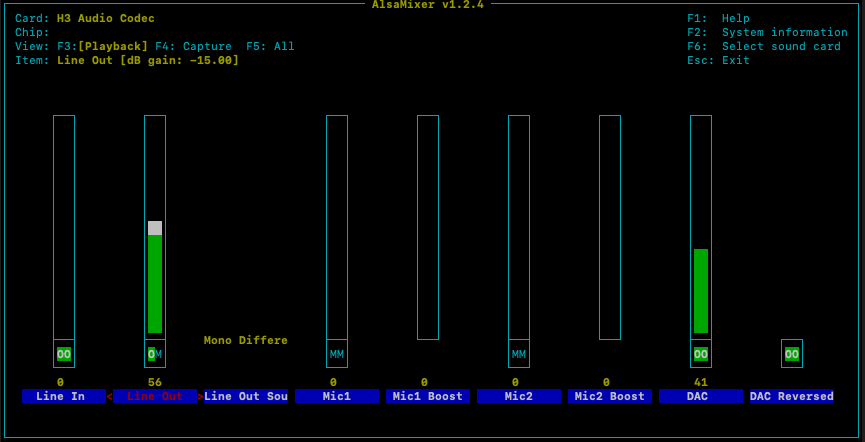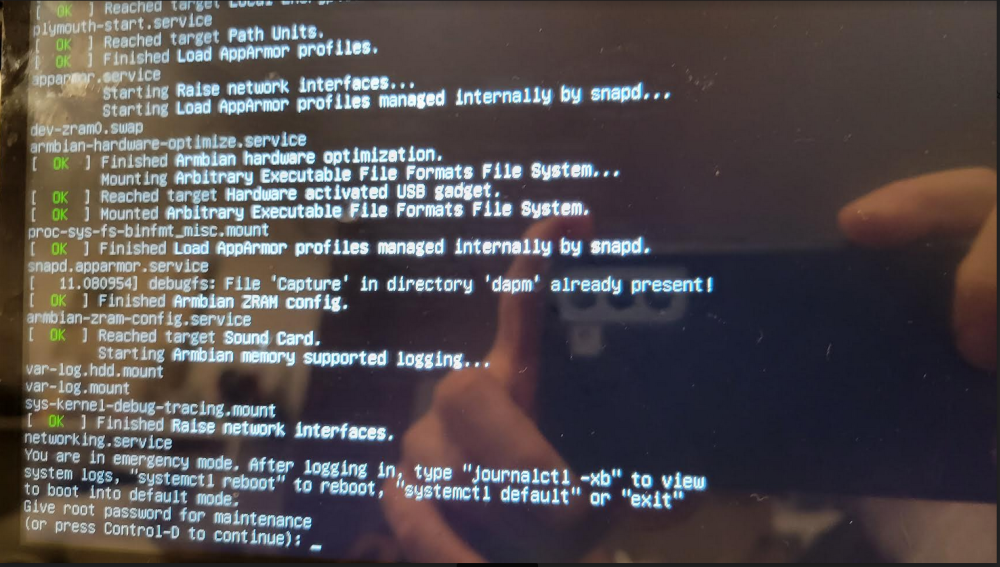Search the Community
Showing results for tags 'orangepipc'.
-
Hi everyone, Recently I have installed armbian Bookworm on my orangepi pc and i noticed that the LEDs were not working. The system is booting with no issue and I have connected to wifi and did an initial software update and bootloader update and still the issue is persisting. So I clean installed jammy on the pi to check it again and still the led was not working. Please help me out on this issue, and if anything more is required please do let me know.
-
My setup is SD boot and rootfs on ssd on USB 2.0 smartctl on laptop reports TIRM is enabled, but it is missing on orange pi PC. using the same SSD in the same USB box. Do I need another ssd, USB box, or armbian upgrade for TRIM support? root@focal-armv7l ~ $ fstrim -v / fstrim: /: the discard operation is not supported root@focal-armv7l ~ $ mount | grep " / " /dev/sda1 on / type ext4 (rw,noatime,nodiratime,discard,errors=remount-ro,commit=600) root@focal-armv7l ~ $ smartctl -i -d sat /dev/sda smartctl 7.1 2019-12-30 r5022 [armv7l-linux-5.9.14-sunxi] (local build) Copyright (C) 2002-19, Bruce Allen, Christian Franke, www.smartmontools.org === START OF INFORMATION SECTION === Device Model: SSD 128GB Serial Number: GS20231128661058 LU WWN Device Id: 0 000000 000000000 Firmware Version: HT3618C8 User Capacity: 128,035,676,160 bytes [128 GB] Sector Size: 512 bytes logical/physical Rotation Rate: Solid State Device Form Factor: 2.5 inches Device is: Not in smartctl database [for details use: -P showall] ATA Version is: ACS-4 T13/BSR INCITS 529 revision 5 SATA Version is: SATA 3.2, 6.0 Gb/s (current: 1.5 Gb/s) Local Time is: Wed Feb 7 06:02:15 2024 EET SMART support is: Available - device has SMART capability. SMART support is: Enabled # Missing TRIM support lsblk -D also reports zeros for discard root@focal-armv7l ~ $ lsblk -D NAME DISC-ALN DISC-GRAN DISC-MAX DISC-ZERO sda 0 0B 0B 0 ├─sda1 0 0B 0B 0 └─sda2 0 0B 0B 0 mmcblk0 0 4M 3.5G 0 ├─mmcblk0p1 0 4M 3.5G 0 └─mmcblk0p2 0 4M 3.5G 0 zram0 0 4K 2T 0 zram1 0 4K 2T 0 I'm using previous armbian ver. Can an upgrade help to solve the missing trim issue? root@focal-armv7l ~ $ cat /etc/*release # PLEASE DO NOT EDIT THIS FILE BOARD=orangepipc BOARD_NAME="Orange Pi PC" BOARDFAMILY=sun8i BUILD_REPOSITORY_URL=https://github.com/armbian/build BUILD_REPOSITORY_COMMIT=b9814056 DISTRIBUTION_CODENAME=focal DISTRIBUTION_STATUS=supported VERSION=20.11.3 LINUXFAMILY=sunxi BRANCH=current ARCH=arm IMAGE_TYPE=stable BOARD_TYPE=conf INITRD_ARCH=arm KERNEL_IMAGE_TYPE=Image IMAGE_UUID=3d974917-e04a-4ec3-bc8a-cc3d2427eb76 # PLEASE DO NOT EDIT THIS FILE BOARD=orangepipc BOARD_NAME="Orange Pi PC" BOARDFAMILY=sun8i BUILD_REPOSITORY_URL=git@github.com:armbian/build.git BUILD_REPOSITORY_COMMIT=e846ef656-dirty DISTRIBUTION_CODENAME=focal DISTRIBUTION_STATUS=supported VERSION=21.02.3 LINUXFAMILY=sunxi BRANCH=current ARCH=arm IMAGE_TYPE=stable BOARD_TYPE=conf INITRD_ARCH=arm KERNEL_IMAGE_TYPE=Image DISTRIB_ID=Ubuntu DISTRIB_RELEASE=20.04 DISTRIB_CODENAME=focal DISTRIB_DESCRIPTION="Ubuntu 20.04.6 LTS" NAME="Ubuntu" VERSION="20.04.6 LTS (Focal Fossa)" ID=ubuntu ID_LIKE=debian PRETTY_NAME="Ubuntu 20.04.6 LTS" VERSION_ID="20.04" HOME_URL="https://www.ubuntu.com/" SUPPORT_URL="https://help.ubuntu.com/" BUG_REPORT_URL="https://bugs.launchpad.net/ubuntu/" PRIVACY_POLICY_URL="https://www.ubuntu.com/legal/terms-and-policies/privacy-policy" VERSION_CODENAME=focal UBUNTU_CODENAME=focal P.S. ix.io is taking a break
-
Hi, I am building a voice assistant on OrangePiPc on latest Armbian 23.11.1 Bookworm \l root@orangepipc:/etc/alsa# aplay -l **** List of PLAYBACK Hardware Devices **** card 0: Codec [H3 Audio Codec], device 0: CDC PCM Codec-0 [CDC PCM Codec-0] Subdevices: 1/1 Subdevice #0: subdevice #0 card 1: sun9ihdmi [sun9i-hdmi], device 0: SUN9I-HDMI PCM i2s-hifi-0 [SUN9I-HDMI PCM i2s-hifi-0] Subdevices: 1/1 Subdevice #0: subdevice #0 For some reason when I plan an audio file using cvlc or play cli tools, about 1 first second of audio is skiped for some reason. I guess this time DAC is initialized. How I can solve this issue?
-
Hi there, I am trying to build a voice assistant using OrangePiPc. This is not orangepi zero, but I am posting it here, because there is no subthread for orangepipc. OrangePiPc has an embedded microphone, but for some reason it doesn't work. When I run arecord, I get an input/output error. Any ideas? Here is a board description: http://www.orangepi.org/orangepiwiki/index.php/Orange_Pi_PC arecord -l card 0: Codec [H3 Audio Codec], device 0: CDC PCM Codec-0 [CDC PCM Codec-0] Subdevices: 1/1 Subdevice #0: subdevice #0 root@orangepipc:~# aplay -l **** List of PLAYBACK Hardware Devices **** card 0: Codec [H3 Audio Codec], device 0: CDC PCM Codec-0 [CDC PCM Codec-0] Subdevices: 1/1 Subdevice #0: subdevice #0 card 1: sun9ihdmi [sun9i-hdmi], device 0: SUN9I-HDMI PCM i2s-hifi-0 [SUN9I-HDMI PCM i2s-hifi-0] Subdevices: 1/1 Subdevice #0: subdevice #0 root@orangepipc:~# arecord -d 5 -f cd -t wav hello.wav Recording WAVE 'hello.wav' : Signed 16 bit Little Endian, Rate 44100 Hz, Stereoarecord: pcm_read:2221: read error: Input/output error root@orangepipc:~# cat /etc/issue Armbian 23.11.1 Bookworm \l root@orangepipc:~# uname -a Linux orangepipc 6.1.63-current-sunxi #1 SMP Mon Nov 20 10:52:19 UTC 2023 armv7l GNU/Linux
-
Hi forum members, when I try to install the headers via: "sudo apt-get install linux-headers-$(uname -r)" I gote these errors: Reading package lists... Done Building dependency tree Reading state information... Done E: Unable to locate package linux-headers-5.19.93-sunxi E: Couldn't find any package by glob 'linux-headers-5.19.93-sunxi' E: Couldn't find any package by regex 'linux-headers-5.19.93-sunxi'
-
Hello, I'm new to working with Armbian and Linux in general, but I have a HiLetgo VK172 G-Mouse USB GPS/GLONASS USB GPS receiver connected to my Orange Pi PC. When I open it with MINICOM, I get a response, but it doesn't give me the coordinates: $GPGSA,A,1,,,,,,,,,,,,,99.99,99.99,99.99*30 $GPGSV,1,1,01,27,,,22*7D L,,,,,203410.00,V,N*4E $GPRMC,203411.00,V,,,,,,,031223,,,N*79 $GPVTG,,,,,,,,,N*30 $GPGGA,203411.00,,,,,0,00,99.99,,,,,,*63 ... But I want to open it for serial communication in /dev/ttyACM0. Thank you very much, and any help you can give me would be appreciated.
-
armbianmonitor -u hastebin - yadagozohu (armbian.com) Using https://redirect.armbian.com/region/NA/orangepipc/Jammy_current image Attached is the output from the serial console for uboot etc. The console is using about half the vertical resolution, and a little under half the horizontal resolution of the HDMI monitor. In contrast, the orangepi.org built image is using the full resolution. Image: Orange Pi PC 2.0.8 based on Debian Buster Kernel: root@orangepipc:~# uname -a Linux orangepipc 5.4.65-sunxi #2.0.8 SMP Mon Oct 26 10:20:38 CST 2020 armv7l GNU/Linux In Armbian, I've tried using extraargs=video=sunxi:1920x1080@60,monitor=hdmi,hpd=0,edid=0 in armbianEnv.txt I've also tried using setenv video-mode sunxi:1920x1028@60,monitor=hdmi,hpd=0,edid=0 ... saveenv in boot.cmd and recompile the boot.scr mkimage -C none -A arm -T script -d /boot/boot.cmd /boot/boot.scr and reboot twice. Still uses only "half resolution". serial-console.log
-
First time working with usb_f_uac1. Running buster image. I have a configfs setup that hosts are able to enumerate but the attributes for capture (c_chmask, c_ssize, c_srate) and playback (p_chmask, p_ssize, p_srate) seem to be switched. i.e. c_chmask = 0x3f shows as a 6-channel capture endpoint on both Windows (ksstudio) and macOS (system information) hosts. Is there something I’m misunderstanding here? Is there something I’m not doing correctly?
-
I'm connecting my Orange PI PC 3.5mm jack to this power amp: HiLetgo 5pcs PAM8403 2x 3W Mini Digital Power Amplifier Board AMP Class D 2.5-5V Input If I connect a 5v 2a power supply to the amp and a 3a 5v power supply to the Orange PI PC, it sounds great with no noise form the Orange PI and no distortion from the amp power supply. If I try to run the amp from the 5v pins on the Orange PI PC with the 3amp 5v supply, it will work, but there is a lot of noise from the main board and the amp does not get enough power to run properly. Should 3a be enough to run both these peripherals? I think the power amp will pull about 600ma, not sure what the Orange PI PC will pull. I also want to connect a small 3.3v 2.8 inch LCD display to the board as well. I think I'll need two supplies to make this work with no interference noise unless there is an isolation trick for the amp. I also don't see wall pugs over 3a if I need more power. Any suggestions?
-
I'm on an Orange PI PC running Armbian_23.08.0-trunk_Orangepipc_bullseye_edge_6.5.1_minimal I've enabled analog audio out the 3.5mm jack using overlays=analog-codec in /boot/armbianEnv.txt I'm connecting the analog 3.5mm jack to a 3watt amp & speakers. It works mostly, but I only get audio on the left channel. Alsa mixer Line Out only allows one channel to be unmuted at a time - left channel or right channel. Left channel sounds pretty good (DAC reversed appears to increase dynamic output). Right channel is very low volume and appears to be "squelched" - is the audio signal reversed from ground or something? Anyway, is there some way to get stereo output working similar to a USB sound card with stereo DAC? I'm currently connecting the left channel to both left/right inputs to my amp and that appears to be working well. Any audiophiles out there get stereo working through the 3.5mm jack?
-
I'm trying to get a HDMI LCD touchscreen working. The pinout is compatible with Orange PI PC except the SPI CS pin is on pin 26 (WPI 11) instead of pin 24 (WPI 10). Is there an easy way to move the SPI CS pin to another GPIO pin? Also, I'm not sure how to properly configure the pen down interrupt pin for pin 22 (WPI 6) So far, I've got the following working: Image: Orangepipc_2.0.8_debian_buster_desktop_linux5.4.65.7z Touchscreen: 3.5 Inch HD HDMI USB LCD Touch Screen 3.5" Display Module 480×320 1920x1080 for Raspberry Pi 3rd 4th Generation 4B/3B+/3B/2B orangepiEnv.txt: overlays=spi-add-cs1 spi-spidev param_spidev_spi_bus=0 param_spidev_spi_cs=0 Luckily, the kernel headers are loaded, so Makefile works. mkdir ds7846 cd ds7846 wget https://sourceforge.net/p/openipmi/linux-ipmi/ci/master/tree/drivers/input/touchscreen/ads7846.c?format=raw mv ads7846.c?format=raw ads7846.c nano Makefile: obj-m := ads7846.o KDIR := /lib/modules/$(shell uname -r)/build PWD := $(shell pwd) all: $(MAKE) -C $(KDIR) M=$(PWD) modules clean: $(MAKE) -C $(KDIR) M=$(PWD) clean install: $(MAKE) -C $(KDIR) M=$(PWD) modules_install make make install depmod cd .. git clone https://github.com/notro/fbtft_tools/ cd fbtft_tools/ads7846_device make make install depmod cd .. sudo nano /etc/modules-load.d/99-ads7846.conf ads7846 ads7846_device sudo nano /etc/modprobe.d/ads7846_device.conf options ads7846_device model=7846 verbose=2 cs=0 gpio_pendown=1 keep_vref_on=1 swap_xy=1 pressure_max=255 x_plate_ohms=60 x_min=200 x_max=3900 y_min=200 y_max=3900 after reboot, the SPI device is there and the touch driver attaches to the port. [ 7.124454] ads7846_device: loading out-of-tree module taints kernel. [ 7.125336] ads7846_device: ads7846_device_init() [ 7.125343] ads7846_device: SPI devices registered: [ 7.125354] ads7846_device: spidev spi0.0 1000kHz 8 bits mode=0x00 [ 7.125357] ads7846_device: [ 7.125366] ads7846_device: Settings: [ 7.125369] ads7846_device: model = 7846 [ 7.125372] ads7846_device: gpio_pendown = 1 [ 7.125375] ads7846_device: swap_xy = 1 [ 7.125378] ads7846_device: x_min = 200 [ 7.125380] ads7846_device: x_max = 3900 [ 7.125383] ads7846_device: y_min = 200 [ 7.125386] ads7846_device: y_max = 3900 [ 7.125388] ads7846_device: x_plate_ohms = 60 [ 7.125391] ads7846_device: pressure_min = 0 [ 7.125393] ads7846_device: pressure_max = 255 [ 7.125396] ads7846_device: keep_vref_on = 1 [ 7.125398] ads7846_device: vref_delay_usecs = 0 [ 7.125401] ads7846_device: vref_mv = 0 [ 7.125403] ads7846_device: settle_delay_usecs = 0 [ 7.125406] ads7846_device: penirq_recheck_delay_usecs = 0 [ 7.125409] ads7846_device: y_plate_ohms = 0 [ 7.125411] ads7846_device: debounce_max = 0 [ 7.125414] ads7846_device: debounce_tol = 0 [ 7.125416] ads7846_device: debounce_rep = 0 [ 7.125425] ads7846_device: Deleting spi0.0 [ 7.126442] ads7846 spi0.0: spi0.0 supply vcc not found, using dummy regulator [ 7.144047] ads7846 spi0.0: touchscreen, irq 65 [ 7.144980] input: ADS7846 Touchscreen as /devices/platform/soc/1c68000.spi/spi_master/spi0/spi0.0/input/input1 [ 7.145055] ads7846_device: SPI devices registered: [ 7.145063] ads7846_device: ads7846 spi0.0 2000kHz 8 bits mode=0x00 [ 7.145066] ads7846_device: Of course, no touch events are detected. Anyone else have any luck getting this to work? I'm not familiar with changing the device tee to move GPIO pins, is there a configuration option for the spi_add_cs1?
-
Hello. I faced with a problem, I can't disable ipv6 completely on Armbian 23.05.1. Orange Pi PC. Tried to use armbian-config to disable ipv6 in Network menu, but no luck, apps can use it at the moment netstat -tulpn | grep ::: gives me udp6 0 0 :::53 :::* 1134/pihole-FTL udp6 0 0 :::111 :::* 1/init Thanks in advance.
-
Hi, hardware / OS = OrangePi PC with Armbian 22.04.2 Ubuntu When executing following command "ssh -D 1080 user@domain" the system doesn't create / open ssh port where it should listen too. I can verify this with command "ps aux | grep ssh". I edited /etc/ssh/sshd_config file by enabling following lines AllowTcpForwarding yes PermitTunnel yes What else do I have to do in order to be able to start ssh proxy server? I was following this guide https://www.digitalocean.com/community/tutorials/how-to-route-web-traffic-securely-without-a-vpn-using-a-socks-tunnel Thank you.
-
Hi gang. I am having a consistent problem changing the board over boot from the SD with the system on any kind of USB attached drive. The drive I want to put it on is a 1t ssb, which otherwise formats fine, over and over again, burns images on it fine (though rpi doesn't like how much power it grabs). But I duplicated the problem with a formatted SD card in a reader in the USB port as well. The same error message appeared. Now I have to say that I have read this post here: to see if there was anything unique to the H3 to accomplish this, but Igor said there to just follow the simple directions at Getting Started, which though dated, still work close to the same. This just seems busted to me. I don't know. I am attaching the final screen I am getting, and tried to >/tmp/boot.txt with the journal command it says to do, but though I saw the file in the /tmp after I did it on the board, it was neither in the /tmp of the original file system or the copied one. Thanks as always.
-
I have an orangepi pc and am trying to use a 3.5 inch TFT-LCD using fbtft. I was told to use armbian 20.05.4_Orangepipc_focal_current_5.4.45 in this case. I am trying to find version 5.4.45. But it hasn't worked out yet. The oldest in the archive is version 5.10. May I know how to find the 5.4.45 version? Please tell us
-
Currently I receive rustc crashes after memory usage get to 3GB (1GB RAM + 2GB SWAP) when building firefox. After looking around why, I found that kernel isn't build with lpae extension. Although H3 soc supports lpae (Large Physical Address Extension), but kernel has CONFIG_ARM_LPAE flag not set and so we can't use more than 3GB of memory (1GB is reserved for kernel). (Processors that implement the ARMv7-A Large Physical Address Extension (LPAE), expand the range of accessible physical addresses from 4GB (232 bytes) to 1024GB (240 bytes) a terabyte, by translating 32-bit virtual memory addresses into 40-bit physical memory addresses.) After looking around I found that there isn't any armbian release where this flag is enabled, but other distros have this correctly enabled by default, debian https://wiki.debian.org/DebianKernel/ARMMP openwrt I also wonder if used build options are generic or did they make use of CPU extensions. H3 also supports VFPv4 or VFPv4-D32 for H3 example: -march=armv7ve -mtune=cortex-a7 -mfloat-abi=hard -mfpu=neon-vfpv4 my output from cat /proc/cpuinfo orangepi-PC processor : 3 model name : ARMv7 Processor rev 5 (v7l) BogoMIPS : 65.14 Features : half thumb fastmult vfp edsp neon vfpv3 tls vfpv4 idiva idivt vfpd32 lpae evtstrm CPU implementer : 0x41 CPU architecture: 7 CPU variant : 0x0 CPU part : 0xc07 CPU revision : 5
-
Hi. I want to install RTL8188fu on this orange pi pc but I have no luck. Bus 003 Device 005: ID 0bda:f179 Realtek Semiconductor Corp. RTL8188FTV 802.11b/g/n 1T1R 2.4G WLAN Adapter I'm using this repository https://github.com/kelebek333/rtl8188fu , but....: orangepipc:~:# sudo dkms install ./rtl8188fu Creating symlink /var/lib/dkms/rtl8188fu/1.0/source -> /usr/src/rtl8188fu-1.0 Error! Your kernel headers for kernel 5.15.93-sunxi cannot be found. Please install the linux-headers-5.15.93-sunxi package or use the --kernelsourcedir option to tell DKMS where it's located. sudo apt install linux-headers-$(uname -r) Reading package lists... Done Building dependency tree... Done Reading state information... Done E: Unable to locate package linux-headers-5.15.93-sunxi E: Couldn't find any package by glob 'linux-headers-5.15.93-sunxi' Thanks in advance.
-
I can't set up gpio-poweroff feature described here. I tried made overlays from here and here - no effect. U-boot boots with no errors. Then i am tried to edit DT (armbian-config > System > Dtc), - manually add node at pinctrl@1c20800: and node at "/": where 0 21 0 means "PA 21 drive_active_high", i assume. So "Reference to non-existent node or label "pio"" error is occured. Then I use gpios = <0x0e 0x00 0x15 0x00>; for PA21 (like it used in leds node for pwr_led on PA10 by changing 0x0a to 0x15 (PA21)). No errors occured but it still not work. Also pwr_off_pins labels in Dtc was repaced by phandle = <0x7f>; and pinctrl-0 = <0x7f>; after compilation. PA21 is free pin. How to make it work? Welcome message:
-
Hi, I am a Grade 12 STEM Student, and right now I need someone's help on our Investigatory Project. Can someone help me on how to connect screen saver (turns off automatically when snoozing) and turns on when PIR Sensor detected something so that It saves power when not used. And I also need to know how do I connect it to the Smart TV because our project is basically an Interactive Board (The thing that you can find around malls which you can use to know specific locations around the mall.) What I have: 1. Orange Pi 2. PIR Sensor 3. Smart TV What I need: 1. A step-by-step procedure on how to do it. 2. What commands/codes to input (Right now, we are using Python language but you can suggest other languages that we can use.)
-
- Orange Pi PC
- Orange Pi PC 2
-
(and 2 more)
Tagged with:
-
I've been reading on the forums on the possibility of having multiple OSes inside 1 EMMC for the Opi PC+. From what I understand, inside a typical EMMC installation, it has 3 partitions: 1) Bootloader partition, which runs first and starts the main partition 2) main partition, contains OS files 3) unallocated free space suppose I have 2 devices: 1. Armbian Jammy Server 2. Armbian Jammy Desktop Now I want to make another device that has 2 OS partitions, like so: 1) Bootloader 2) 1st OS main partition, 3) 2nd OS main partition, 4) unallocated free space I'm thinking of using DD to extract the image out from 1 OS and dd it back into the other (booting the devices using another OS from SD card). I'm guess taking out the desktop image and put it inside the server device... If this is done, how do I make it so that the 2nd OS is bootable? It can be like this: 1) Select which OS to boot on startup ala GRUB 2) Boot into 1st OS, then boot into 2nd OS from 1st OS. I want to make this as a way to make the 2nd OS robust. 2nd OS is the work OS, 1st OS is diagnostics OS. The idea is to make the 1st OS able to fsck/remote rsync the 2nd OS OS in case the 2nd OS corrupts/needs updates.
-
I have an Orange Pi PC Plus (Armbian Bullseye CLI) that I'm using as a NUT server connecting to a Cyberpower UPS. Every 30 minutes the driver stops working and upon further investigation, this looks to be a USB connection issue. Is there some power-saving mode that would cause this or any other known issue? Thanks!
-
Hi. I was following a tutorial on how to set up my Orange pi PC. I installed this image: RetrOrangePi_v4.3_Armbian_5.97_Orangepipc_Ubuntu_bionic_dev_5.2.14_desktop.img. So I installed it. Everything ran fine and I can navigate the menus. The device I have is very similar to this one, it's a v1.3: https://imgur.com/FN1sBZF The problem is that, when I try to connect to the device using Filezilla it displays the following message: https://imgur.com/1WZI885 Yes the port I used is 22. Password: "PI" or "pi" I only have one ethernet cable, I plug that into the orange pi and I connect my PC using wifi. I've done this before with my Playstation 3, only difference is that, the PS3 is connected to my wifi and the pc is using the ethernet cable. I don't know. I hope somebody can help me. Thank you!.
-
Hi, Im using orangepi pc with armbian jammy. On download section there is only 2 choices, CLI and Desktop. Is there a custom desktop version where most (or if possible all) applications are not installed? It would take too long is I uninstall it one by one. I think I only need browser and terminal.
-
Hi!, I just bought my orangepi pc and also installed Armbian desktop. I also bought a wifi dongle with rtl8188gu chip. Is there any steps on how to use this to connect to my network?










